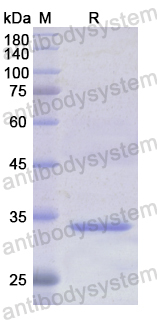Catalog No.
YHA14001
Expression system
E. coli
Species
Homo sapiens (Human)
Protein length
Met1-Ser276
Predicted molecular weight
33.90 kDa
Nature
Recombinant
Endotoxin level
Please contact with the lab for this information.
Purity
>90% as determined by SDS-PAGE.
Accession
O00499
Applications
ELISA, Immunogen, SDS-PAGE, WB, Bioactivity testing in progress
Form
Lyophilized
Storage buffer
Lyophilized from a solution in PBS pH 7.4, 0.02% NLS, 1mM EDTA, 4% Trehalose, 1% Mannitol.
Reconstitution
Reconstitute in sterile water for a stock solution. A copy of datasheet will be provided with the products, please refer to it for details.
Shipping
In general, proteins are provided as lyophilized powder/frozen liquid. They are shipped out with dry ice/blue ice unless customers require otherwise.
Stability and Storage
Use a manual defrost freezer and avoid repeated freeze thaw cycles. Store at 2 to 8°C for frequent use. Store at -20 to -80°C for twelve months from the date of receipt.
Alternative Names
AMPHL, Myc box-dependent-interacting protein 1, Amphiphysin II, Amphiphysin-like protein, Box-dependent myc-interacting protein 1, Bridging integrator 1, BIN1
Early-Stage Morphogenesis of T-Tubules in Rat Cardiomyocytes: The Role of pBIN1., PMID:40509990
Cell-type-specific Transcriptomic-wide Association Studies Detected 91 Independent Risk Genes for Alzheimer's Disease Dementia., PMID:40492066
Bend it like BIN1: how a membrane-curving adaptor protein shapes cardiac physiology., PMID:40392240
STAU1 exhibits oncogenic characteristics and modulates alternative splicing and gene expression in lung adenocarcinoma cells., PMID:40379812
From function to structure: how myofibrillogenesis influences the transverse-axial tubular system development and its peculiarities., PMID:40352140
Tumor cell-intrinsic BIN1 deficiency promotes the immunosuppression and impedes ferroptosis of non-small cell lung cancer via G3BP1-mediated degradation of STAT1., PMID:40346580
Association of Alzheimer's-Related Gene Variants with Autism Spectrum Disorder: A Case-Control Study in an Iraqi Cohort., PMID:40327194
Integrating analysis of multi-omics summary data identifies novel plasma protein biomarkers and drug targets for bladder cancer., PMID:40316856
BIN1 gene replacement reverses BIN1-related centronuclear myopathy., PMID:40308061
Identifying therapeutic target genes for diabetic retinopathy using systematic druggable genome-wide Mendelian randomization., PMID:40301928
BIN1 and Alzheimer's disease: the tau connection., PMID:40268578
Uncovering leading compounds for alzheimer's disease treatment: mendelian randomization and virtual screening insights into plasma protein modulation., PMID:40186323
Large-scale Plasma Proteomic Profiling Unveils Novel Diagnostic Biomarkers and Pathways for Alzheimer's Disease., PMID:40166037
A polymorphism in the BIN1 gene influences its expression and is associated with the risk of Alzheimer's disease: An integrated analysis., PMID:40138448
BIN1 reduction ameliorates DNM2-related Charcot-Marie-Tooth neuropathy., PMID:40042903
Integrative Epigenomic Landscape of Alzheimer's Disease Brains Reveals Oligodendrocyte Molecular Perturbations Associated with Tau., PMID:40027794
BIN1 inhibited tumor growth, metastasis and stemness by ALDH1/NOTCH pathway in bladder carcinoma., PMID:40016843
Establishment of iPSC-Derived MSCs Expressing hsa-miR-4662a-5p for Enhanced Immune Modulation in Graft-Versus-Host Disease (GVHD)., PMID:39859561
Genome-wide association neural networks identify genes linked to family history of Alzheimer's disease., PMID:39775791
Neuropathology-based approach reveals novel Alzheimer's Disease genes and highlights female-specific pathways and causal links to disrupted lipid metabolism: insights into a vicious cycle., PMID:39755674
European EHBP1L1 Genotyping Survey of Dyserythropoietic Anemia and Myopathy Syndrome in English Springer Spaniels., PMID:39728936
[Association between serum BIN1 level and Killip class in patients with acute myocardial infraction]., PMID:39725628
Identification of Alzheimer's disease susceptibility genes by integrating eight human brain single-cell transcriptomes with genome-wide association studies., PMID:39655660
Pure LATE-NC: Frequency, clinical impact, and the importance of considering APOE genotype when assessing this and other subtypes of non-Alzheimer's pathologies., PMID:39546031
Molecular mechanisms of complex-type N-glycan breakdown and metabolism by the human intestinal bacterium Barnesiella intestinihominis., PMID:39510934
Novel targets for the treatment and prevention of Alzheimer's disease in the European population, inspiration from amyloid beta and tau protein., PMID:39492919
Decitabine Enhances Sorafenib Sensitivity in Renal Cell Carcinoma by Promoting BIN1 and SYNE1 Expressions., PMID:39473430
Molecular Dynamics Reveal Key Steps in BAR-Related Membrane Remodeling., PMID:39452773
Association of common and rare variants with Alzheimer's disease in more than 13,000 diverse individuals with whole-genome sequencing from the Alzheimer's Disease Sequencing Project., PMID:39428839
Hypothesis-based investigation of known AD risk variants reveals the genetic underpinnings of neuropathological lesions observed in Alzheimer's-type dementia., PMID:39424714
SRPK Inhibitors Reduce the Phosphorylation and Translocation of SR Protein Splicing Factors, thereby Correcting BIN1, MCL-1 and BCL2 Splicing Errors and Enabling Apoptosis of Cholangiocarcinoma Cells., PMID:39344395
SRSF2 is a key player in orchestrating the directional migration and differentiation of MyoD progenitors during skeletal muscle development., PMID:39248331
sTREM2 Mediates the Correlation Between BIN1 Gene Polymorphism and Tau Pathology in Alzheimer's Disease., PMID:39240638
BIN1 deficiency enhances ULK3-dependent autophagic flux and reduces dendritic size in mouse hippocampal neurons., PMID:39171951
Uncovering the BIN1-SH3 interactome underpinning centronuclear myopathy., PMID:38995680
Rapid flow-based synthesis of post-translationally modified peptides and proteins: a case study on MYC's transactivation domain., PMID:38873065
NMT2 alleviates depression-like behavior in a rat model of chronic unpredictable stress: An integrated proteomic and phosphoproteomic analysis., PMID:38852542
Labeling and Diagnostic Value of miRNA-28-3p in Patients with Nasopharyngeal Carcinoma., PMID:38814613
BIN1 regulates actin-membrane interactions during IRSp53-dependent filopodia formation., PMID:38724689
Dynamics of membrane tubulation coupled with fission by a two-component module., PMID:38717859
A systems biology-based identification and in vivo functional screening of Alzheimer's disease risk genes reveal modulators of memory function., PMID:38692279
Involvement of transposable elements in Alzheimer's disease pathogenesis., PMID:38680184
BIN1 knockdown rescues systolic dysfunction in aging male mouse hearts., PMID:38664444
Unveiling Gene Interactions in Alzheimer's Disease by Integrating Genetic and Epigenetic Data with a Network-Based Approach., PMID:38651367
Unveiling DNA methylation in Alzheimer's disease: a review of array-based human brain studies., PMID:38526273
[A new mechanism by which cancers can circumvent cisplatin resistance: The E2F1/BIN1 axis]., PMID:38520097
The Alzheimer's disease risk gene BIN1 regulates activity-dependent gene expression in human-induced glutamatergic neurons., PMID:38514804
Amphiphysin-2 (BIN1) functions and defects in cardiac and skeletal muscle., PMID:38514365
BIN1K358R suppresses glial response to plaques in mouse model of Alzheimer's disease., PMID:38460121
Identification of binding partners that facilitate membrane-type 5 matrix metalloproteinase (MT5-MMP) processing of amyloid precursor protein., PMID:38345408

